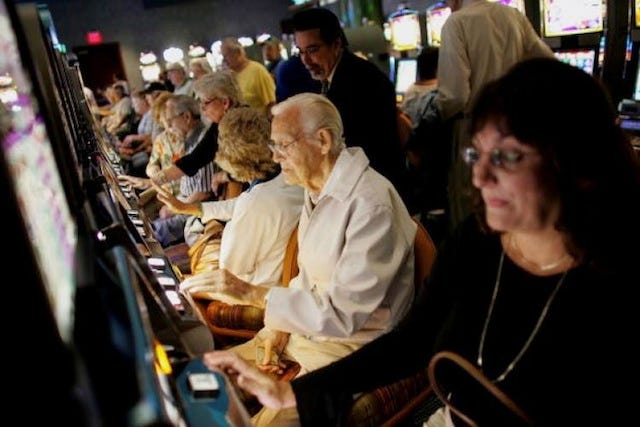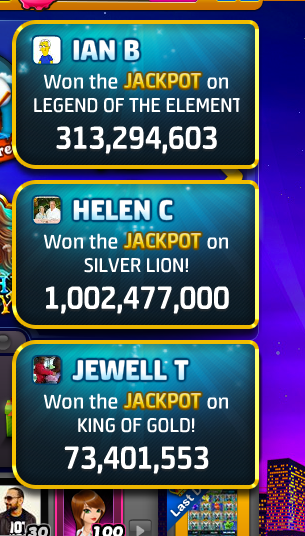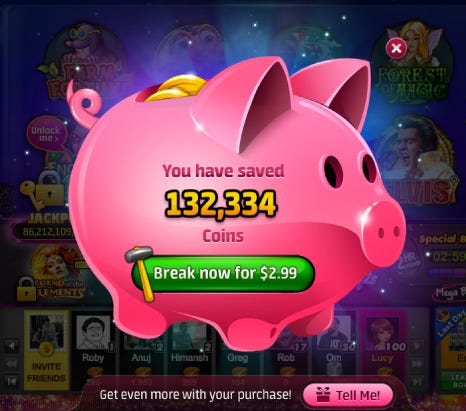Trending
Opinion: How will Project 2025 impact game developers?
The Heritage Foundation's manifesto for the possible next administration could do great harm to many, including large portions of the game development community.

Featured Blog | This community-written post highlights the best of what the game industry has to offer. Read more like it on the Game Developer Blogs or learn how to Submit Your Own Blog Post
Deep dive in to hooks and baits of social casino games, utilisation of psychological principles for unique monetisation and conversion opportunities.

 10 out of 50 US top grossing games are social casino giants, an indication of how dominant this genre is with an massively loyal target audience.
10 out of 50 US top grossing games are social casino giants, an indication of how dominant this genre is with an massively loyal target audience.


Superdata research predicts massive growth in this segement
You may wonder, why people are sinking millions of dollars in to these games which can not be played for real money! give no cash returns, unlike the real life casinos! & online gambling counterparts!
I remember in 2010 while working at slot machine giant WMS (acquired by scientific gaming for $1.5 billion).
When they launched a variant of their popular flagship (online real money) brand 'Jackpot Party' as an F2P game on Facebook, everyone was genuinely surprised, it racked up 25K overnight!!
Traditional casino gaming manufacturers could not fathom what would drive people to play these no real money counterparts? Have they discovered another virgin goldmine waiting to be explored?
Flash forward 2016, a majority of traditional casino industry titans like Caesars Interactive (owns Playtika/ Slotmania), IGT (owns Double Down Interactive), WMS (owns Jackpot Party) now have a dominant presence in top grossing charts via acquisition and mergers of mobile savvy app companies.
The answer of course lies in user behaviour.
But what may hold true of an average person does not hold true of an average gambler. Their intrinsic motivations are quiet different:
For an average person recurring motivation to bet or gamble is the lure of high returns, beating the odds and getting a lucky dip once in a while.
- Engaged gamblers relish the thrill of win and loss, the unpredictability of outcomes, the roller coaster of high rolling ups & downs.
Motivation : In this case more then returns is gambling rush.
It's got more to do with the journey then the destination.
- A massive TA of this genre is Baby Boomer and Millennial (35+ to 60+ demographic) & while casinos do promote themselves as destination for young crowd...

...Ground reality of majority of regular visitors is quiet different

For players in this demographics majority of who are pensioners and retired or working less hours regular visit to casinos for spending time is part of the routine and hence more then occasional gambling it part of their daily time sink.
Motivation : In this case, more than betting is daily routine.
- A lot of people may also be using these games to hone their skills, so they can apply the experience to real money counterparts (believe it or not every second regular casino visitor will have a strategy or tips to handout when it comes to poker, roulette and the kinds)
- 30+ Women, house makers often indulge in playing card games after their daily chores traditionally to kill time and socialise via kitty parties, social casino apps bring the experience right at their fingertips without the need to have other players and at their own convenient time. (Super Data research shows, Latin American middle aged women to be most engaged players)
Motivation : In this case, more than betting is killing time.
- Low barrier to entry via the F2P model, you can buy way more chips/coins for considerably lower investment, play these games a whole lot longer, and probably not feel guilty pangs that you get if you have lost money in a real casino.
The bait is the same but the hooks are not
Social Casino games are not regulated like real money casino games, the stringent rules and testing certification by GLI (Gaming Labs International) the ruling body on real money casino games is not applicable to probability math tables and design of social casino games.
This is the very reason why Zynga backtracked from entering the real money betting games with Zynga poker and slots, they could not get away with their F2P hooks in a highly regulated environment ;)
Which gives them the freedom to apply more aggressive F2P hooks when it comes to engage and monetise players. (we will see how)
Owned by Playtika, which has been a established slot games developer in the traditional casino industry, is a highly polished app, which plays to it's strength of knowing the target segment quiet well.
Players can chose from a wide range of slot games catering to a wide variety of tastes and preferences, what's more they are downloaded as on demand DLC's which does not kills your mobile storage.

The experience and UI has been well crafted with good on boarding for mobile, with auto feature which enables players to keep spinning without the need to press the button continuously.
The game's FTUE is quiet different from real money casino games, the math tables (which are responsible for prize drop) have been modified in a way to ensure new players level up & progress faster wining multiple large prizes to feel rewarded and lucky in the game. This is in direct contrast to real money casino games, where such a distinction is not possible, even if you can detect a new player playing either online or by the slot machine due to heavy compliance and regulation barring such practices.
.jpg/?width=372&auto=webp&quality=80&disable=upscale)
But hooking new players with rewards, easy progression and memorable first time user experience is an essential foundation of F2P games to prevent churn. so it's a natural for social casino games to adopt this practice.
It is quiet important that social elements of playing with friends , other players is virtually recreated in these games to mirror the real life experience. Slotomania's take is on this is, while Players can play their game alone, the game puts players in to tournaments as soon as they start their session to recreate:

The feeling of playing with others.
Generate peer pressure via use of leader boards and rankings (marrying another powerful & competitive F2P games feature)
The tournament feature immediately puts the player in a prize pool, and as I start winning I can see my self climbing the ladder with the possibility of hitting the top 3 tiers in the time limited tournament.
However the game dynamically scales the prize pool as well to ensure player keeps playing and does not gives up feeling reward is too far out of his reach, this balance is also attained by having a small leaderboard where the chance of climbing the ladder is much shorter compared to a large leaderboard, where most casual players will be disheartened to continue. Chances are a lot of the tournament players are bots to generate peer pressure and act of playing in an active community.

You also see from time to time toast notifications that announce which players have hit jackpot which acts as aspirational and vanity matrix for the existing Player to continue playing.
You can see below in-game prompts encourage players to keep spinning by aspiring the player he is near the summit and the big win, so they don't give up and keep playing.

You can see above, how the leaderboard prompts the player to keep playing, thing is even if the leaderboard is large 100+ , you quickly climb to top 25 or 10 just after few spins implying this feature might have been dynamically tailored to each individual players progression and be designed more as an tool which keeps players playing by always dangling the top prizes (carrots) within his reach, rather than a hardcoded leaderboard.
Playtika has studied the grinding aspect of F2P model well which in turn creates opportunity and funnels for monetisation over time, once the player is hooked to the core loop.
Post the 'Honeymoon' (on boarding phase) as player unlocks more games, the amount of coins player is spending in the game become more then what he is earning (this could be because of the math tables that determine prize drop normalise post on boarding phase and fall more in line with real money game math tables).
.jpg/?width=646&auto=webp&quality=80&disable=upscale)
This creates pressure on Players to buy more coins.
Slotomania incorporates a very aggressive monetisation model and strategy employed by a F2P game. The games sole hard currency coins acts as energy mechanics of the game as well, if you run out of those you can't play the game effectively.
Daily rewards collected from the game as gift ensure player can play at least a handful of games, if he is grinding. But to play the game for longer periods you eventually need to buy coins.
Slotomania intentionally devaluates it's currency from time to time by giving huge volume discounts as player progresses (it's unlike discount, or sales other games have in their store), chances are the IAP pack value that you get at level 1 will be very different from IAP packs you get at level 20 or level 30, this is because as the players progress, the amount of bets required increase exponentially and to compensate for that sink, and to attract players for repeat purchase, game economy has to link the volume of coins purchased to players level in the game,this player level linked changes in store are unique to Slotomania


Apart from this level linked HC devaluation, Slotomania employs a host of welcome screens IAP offers (at least 3 every time you open the app) time limited offers which are cheaper than in store offers to promote impulse purchase.
In psychology and behavioral economics, the endowment effect (also known as divestiture aversion and related to the mere ownership effect in social psychology) is the hypothesis that people ascribe more value to things merely because they own or create them
Slotomania utilises a unique monetisation model based on endowment effect, it is used as an effective conversion mechanism by making people feel smart about their choices.

You can notice the HUD in ‘Slotomania’ has a pig icon, which is similar to the mental model of a saving piggy bank.

So in essence Slotomania creates an IAP that follows the mental model of a ‘Piggy Bank’ in real life, Player sees his efforts = Winnings + Time spent in the game increments the amount of HC the Pig holds.
But how does this makes Player's feel smarter or different from any other IAP in the game? ...Why would player buy/prefer this offer?

For $3 Shop is offering 45000 coins, and the TLE offer 51,750 coins while breaking the pig only 5000 coins for $2.99.

However as Player keeps playing the game the Piggy bank keeps swelling (remember players every spin, time spent in the game adds free coins in to the pig) and as you can see,
It now offers 132,334 coins for just $2.99!! it beats the lowest shop offer (45000 coins for $3) and the TLE offer (51,750 coins for $3) by a huge margin and looks like a smart buy!!
(remember Player can break the bank for a fixed cost of $2.99 anytime in the game irrespective of the amount it contains)
Psychologically player also feels the amount in the “Piggy Bank” is a result of his own campaign. Amount in the Bank = Time spent by player in the game. Which creates attachment.

The game further promotes the “breaking” of Piggy Bank by offerings promotions, such as if you break your first one, next one would start with x2 saving and so on.
Every time Slotomania runs these promotions, there are complaints too, some NPU’s ask why they need to pay for their own saving bank (piggy bank mental model) .But having observed over 2 years every time piggy bank promotions are run, there is a significant jump in revenue (15-20 %) due to players breaking the bank.
*(Estimates made by observing the difference in revenue on think gaming, by comparing the day promotions are run and the jump day after)
Slotomania offers a very slick and polished experience of slot machines on mobile , the developers have successfully tailored the experience for mobile
Developers have been keeping a sharp eye on what creates engagement and monetisation in F2P games and have successfully incorporated aspects like grinding, on boarding , competitive tournaments and leaderboards to retain and monetise slot game lovers.
Monetisation strategy with an bombardment welcome screen offers, boosts and VIP system can be annoying and feels aggressive.
Piggy Bank IAP model is a uniquely organic funnel of monetization, it creates player attachment via endowment (as player owns the bank & time spent by him in the game directly equals the amount it holds)
It is different from other IAP’s as player can keep nurturing the bank by playing & hence adding volume to it, he only pays a fixed price to break the bank irrespective of the value it holds! unlike other IAP’s with fixed volume.
If you liked this post, you can check out my other Game UX Deconstructs. Feel free to connect with me for my future article.
Read more about:
Featured BlogsYou May Also Like